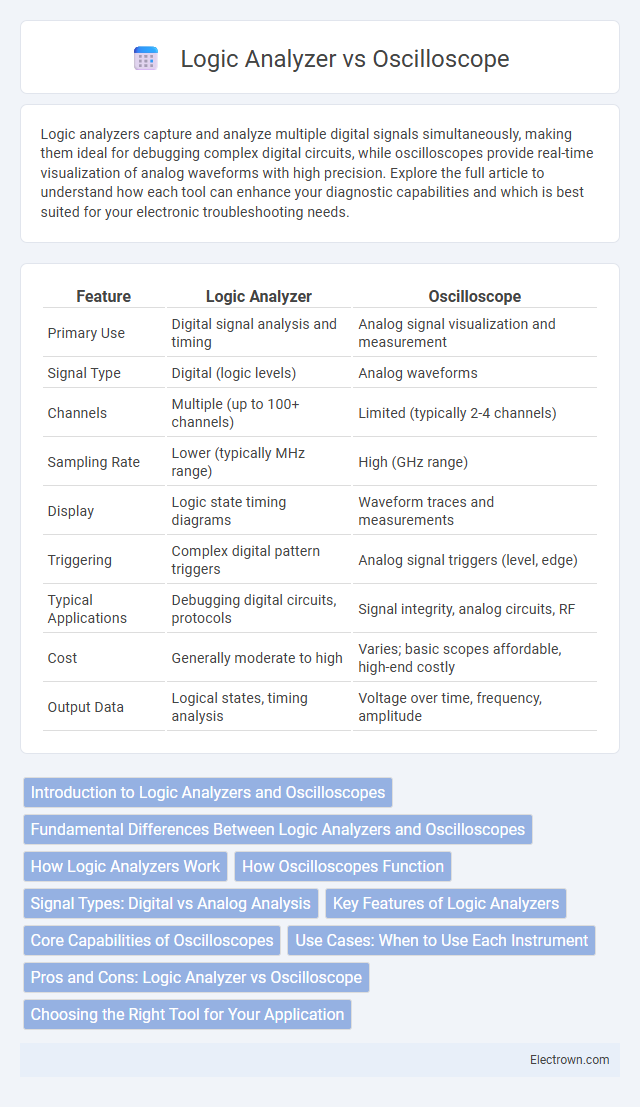Logic analyzers capture and analyze multiple digital signals simultaneously, making them ideal for debugging complex digital circuits, while oscilloscopes provide real-time visualization of analog waveforms with high precision. Explore the full article to understand how each tool can enhance your diagnostic capabilities and which is best suited for your electronic troubleshooting needs.
Table of Comparison
| Feature | Logic Analyzer | Oscilloscope |
|---|---|---|
| Primary Use | Digital signal analysis and timing | Analog signal visualization and measurement |
| Signal Type | Digital (logic levels) | Analog waveforms |
| Channels | Multiple (up to 100+ channels) | Limited (typically 2-4 channels) |
| Sampling Rate | Lower (typically MHz range) | High (GHz range) |
| Display | Logic state timing diagrams | Waveform traces and measurements |
| Triggering | Complex digital pattern triggers | Analog signal triggers (level, edge) |
| Typical Applications | Debugging digital circuits, protocols | Signal integrity, analog circuits, RF |
| Cost | Generally moderate to high | Varies; basic scopes affordable, high-end costly |
| Output Data | Logical states, timing analysis | Voltage over time, frequency, amplitude |
Introduction to Logic Analyzers and Oscilloscopes
Logic analyzers capture and display multiple digital signals simultaneously, allowing detailed timing analysis of complex digital circuits, while oscilloscopes visualize analog signal waveforms, crucial for analyzing voltage, frequency, and signal integrity. Logic analyzers are essential for debugging digital communication protocols and timing relationships, whereas oscilloscopes provide real-time analog signal measurement, ideal for analog and mixed-signal circuits. Understanding your specific application helps determine whether a logic analyzer or oscilloscope best suits your testing needs.
Fundamental Differences Between Logic Analyzers and Oscilloscopes
Logic analyzers capture and display multiple digital signals simultaneously, enabling detailed timing analysis of complex digital systems, while oscilloscopes primarily visualize analog waveforms with high-resolution voltage and time measurements. Logic analyzers are essential for debugging digital circuits with numerous channels, offering protocol decoding and state analysis, whereas oscilloscopes excel at visualizing analog signal integrity, noise, and transient events. Understanding these fundamental differences helps you select the right instrument for digital logic troubleshooting versus analog waveform examination.
How Logic Analyzers Work
Logic analyzers capture and display multiple digital signals simultaneously by sampling their logic states at high speeds, often using parallel inputs and clock synchronization. They convert these digital signals into time-correlated waveforms or state changes, enabling detailed analysis of complex digital circuits and protocols. This precise timing and state tracking allows engineers to debug and verify intricate logic designs beyond the capabilities of oscilloscopes.
How Oscilloscopes Function
Oscilloscopes function by capturing and displaying electrical signal voltages over time, converting analog waveforms into visual graphs on a screen. They provide precise time-domain analysis, allowing users to observe signal amplitude, frequency, and transient events in real-time. Key features include adjustable time base, trigger controls, and voltage scaling, which enable detailed examination of waveform characteristics for troubleshooting and design validation.
Signal Types: Digital vs Analog Analysis
Logic analyzers specialize in capturing and analyzing digital signals, making them ideal for debugging digital circuits by displaying multiple digital lines and timing relationships. Oscilloscopes primarily focus on analog signal analysis, providing detailed waveform shapes, voltage levels, and frequency characteristics essential for examining signal integrity and analog behavior. Choosing between the two depends on whether the task requires monitoring digital logic states or detailed analog waveform examination.
Key Features of Logic Analyzers
Logic analyzers capture and display multiple digital signals simultaneously, providing detailed timing analysis and protocol decoding essential for debugging complex digital circuits. They feature high channel counts, triggering capabilities on specific digital events, and the ability to analyze bus transactions across parallel or serial communication lines. Unlike oscilloscopes, logic analyzers emphasize the logical state and timing relationships of digital signals rather than analog waveform shapes.
Core Capabilities of Oscilloscopes
Oscilloscopes excel at capturing and displaying real-time analog signals with high temporal resolution, allowing precise visualization of voltage changes over time. Their core capabilities include measuring waveform amplitude, frequency, rise time, and noise, making them essential for analyzing signal integrity and diagnosing hardware issues. You can rely on oscilloscopes for detailed insight into electrical circuit behavior through continuous signal monitoring.
Use Cases: When to Use Each Instrument
Logic analyzers excel in capturing and analyzing digital signals across multiple channels, making them ideal for debugging complex digital circuits, timing issues, and protocol verification in embedded systems. Oscilloscopes are best suited for visualizing analog waveforms, measuring signal amplitude, frequency, and noise, thus commonly used in power electronics, RF design, and general signal integrity testing. Selecting between these instruments depends on the signal type--digital for logic analyzers and analog for oscilloscopes--and the specific diagnostic needs of the application.
Pros and Cons: Logic Analyzer vs Oscilloscope
Logic analyzers excel at capturing and analyzing complex digital signals with multiple channels, providing detailed timing and state information ideal for debugging microprocessors and digital systems. Oscilloscopes offer superior analog signal visualization with high bandwidth and real-time waveform analysis, making them indispensable for testing analog circuits and mixed-signal devices. Your choice depends on whether you need deep digital logic insight with many channels (logic analyzer) or precise analog signal resolution (oscilloscope).
Choosing the Right Tool for Your Application
Logic analyzers excel in debugging digital circuits by capturing and analyzing multiple signal channels simultaneously, making them ideal for complex timing analysis and protocol verification. Oscilloscopes are better suited for observing analog waveforms, transient faults, and signal integrity issues in both analog and digital signals. Your choice depends on whether you need detailed digital event correlation or precise analog waveform visualization for your application.
Logic Analyzer vs Oscilloscope Infographic

 electrown.com
electrown.com